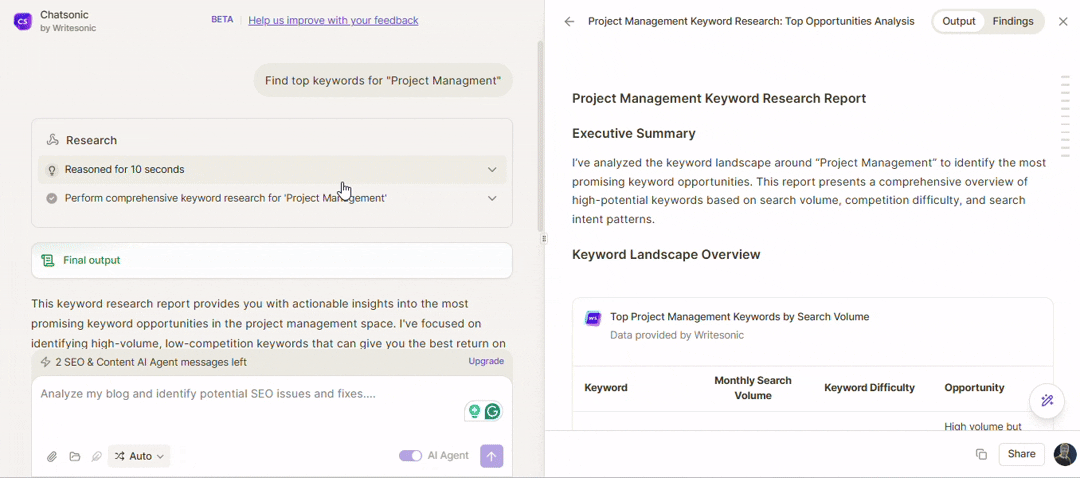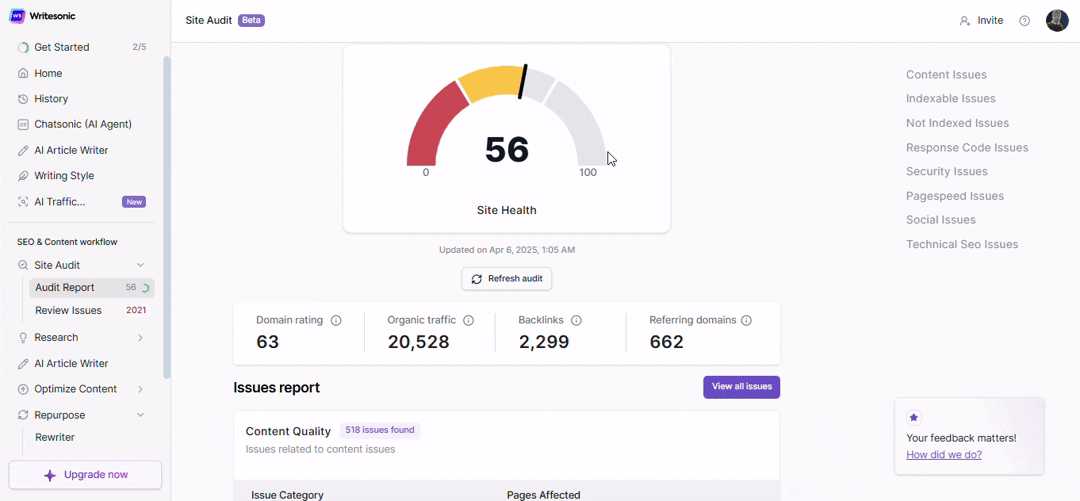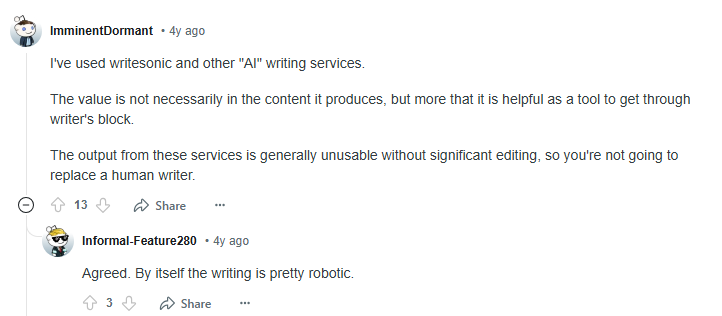
Writesonic
Most people don’t have hours to spend writing blog posts or ad copy from scratch. I certainly don’t. That’s why I started exploring tools like Writesonic, not to replace my writing job, but to speed things up without compromising quality.
There’s no shortage of AI writing tools out there, but this one caught my attention because it offers more than just quick drafts. It handles aspects like SEO structure, grammar suggestions, and repurposing content for different formats.
In this Writesonic review, I’ll walk you through how the platform fits into a real content workflow. From generating blog ideas to rewriting paragraphs that just won’t land, it’s built for hands-on use.
With the AI content creation market projected to hit $7.74 billion by 2029, it’s clear this space is growing fast. This Writesonic review looks at where the tool stands in all that noise.
Features
-
Quickly generate structured long-form content that’s ready for edits or publishing
-
Rewrite awkward sentences or repurpose existing content without changing the original meaning
-
Turn a few words or bullets into full, readable sentences in seconds
-
Create compelling, SEO-friendly descriptions for eCommerce listings with minimal input
-
Build creative narratives from scratch, whether it’s for fiction, brand storytelling, or social media
Pros
-
The built-in tools help reduce content turnaround time
-
It can generate clean, structured drafts that often need minimal rewriting
-
Supports multiple languages, making it a practical option for global teams
-
Surfer SEO integration lets users optimize content for search while they write
-
Allows for repurposing to increase content lifespan
Cons
-
AI-generated suggestions sometimes miss the mark, especially on complex prompts
-
Customization options are limited when creating branded or tone-specific content
Writesonic Review Methodology
Geekflare tested Writesonic’s Chatsonic, site audit, content optimization, and marketing copy. We evaluated ease of use, content quality, competitor research, and combined hands-on experience with user feedback for an unbiased review.
What is Writesonic?

Writesonic helps marketers and content teams speed up their writing and overall content creation process. It’s designed to support tasks like SEO blogs, ad copy, emails, and product descriptions.
What stands out is how it combines structure with automation, especially when you’re dealing with keyword research or following competitors’ content. If you’re managing a high content volume, it can make the workflow feel more manageable.
The company is based in San Francisco and was started in 2020. Since then, it has attracted over five million users, including people in e-commerce, SaaS, and publishing.
But there are two sides to everything, including Writesonic.
One Reddit user put it this way:

I’ve had the same experience. Writing a 1,000-word blog on my own takes three to four hours. With Writesonic, I got the first draft in minutes, but I still had to spend nearly an hour editing it to make it sound right. That’s something worth thinking about.
Ahead in this Writesonic review, I’ll focus on two tools that matter most to writers and marketers: the SEO AI Agent and the Marketing AI Agent.
These tools claim to make writing faster and more accurate, but how well do they hold up?
Chatsonic – AI Marketing Agent

Chatsonic helps marketing teams create content faster by offering templates and guidance tailored for different formats. Whether it’s a product launch email, a Facebook ad, or a LinkedIn post, the tool adapts to fit the need.
You can add specific brand instructions or keywords, and it does a decent job of aligning the output.
One thing that makes Chatsonic practical is how easy it is to switch tones and content types without starting from scratch. The voice-to-text input is another bonus; useful when you want to draft ideas quickly while multitasking.
Alongside Chatsonic, there’s another tool called Botsonic, which focuses on AI-powered customer support. If you’re curious about that, you can check out our Botsonic review for more insights.
I spoke with Kemal Kara, a freelance content strategist who’s been using Chatsonic regularly, and asked him a few questions about it. Here’s what he said:
What Kemal Kara says?

Kemal kara
It saves me time for sure, especially with first drafts. I still rewrite parts of it, but it gives me a structure to build on. It’s like having a junior writer around to brainstorm with.
-
How do you use Chatsonic in your content process?
I mostly use it at the beginning of a campaign. If I’m writing emails or paid ads, I’ll feed in some key points and let it build a rough version. Then, I edited based on tone and intent. It gives me something to work with, especially when I’m tight on deadlines.
-
What’s been the biggest benefit for you?
It saves time during idea development. Sometimes I get stuck on how to start something, and Chatsonic helps me break through that.
Here’s where it helps me the most:
– Quick social media drafts
– Email Headline Ideas
– First-draft ad copy for A/B testing -
Any drawbacks you’ve noticed?
Sometimes, the language feels robotic, especially for informal content. I always rewrite parts of it before sending to clients. But I still prefer that over starting from zero, it helps move faster.
This kind of feedback mirrors what I’ve felt, too. Chatsonic is not perfect, but for quick tasks and structured outlines, it’s a solid companion.
SEO AI Agent

The SEO AI Agent is geared toward marketers and writers who handle search-focused content regularly. It combines keyword targeting, competitor insights, and structural recommendations to help create content that ranks and stays relevant over time.
One of the main advantages is how it builds around search intent. It doesn’t just suggest keywords but helps outline the entire article, from H2s to FAQs.
You can also compare your draft against competing pages to find gaps or missing angles. If you want to refine your SEO strategy, it pairs well with tools like online SEO analyzers, which give a broader performance view.
I asked James Yoo how the SEO AI Agent fits into his client work. He’s been using it for both blog creation and content refresh projects.
What James Yoo says?

James Yoo
As a SEO guy I really loved it how it help in my day to day activity.
-
What kind of content do you use the SEO AI Agent for?
Mostly for blog posts and landing pages. I start with a topic or keyword, and it gives me a rough outline plus some suggested talking points. It’s especially useful for longer content where structure matters.
-
Have you found any big time-savers in it?
Yes. I used to spend a lot of time researching competitors before writing. Now, I get most of that inside the tool itself. It’s not always perfect, but it gives me a solid direction.
-
Anything that still needs improvement?
I wish it gave more variation in tone. For some clients, I need a casual voice, and for others, something more formal. The default style leans toward generic, so I usually rewrite parts of the intro and conclusion.
If you’re producing multiple pieces of SEO content every week, this tool gives you a structured start and speeds up early-stage research.
While you’ll still need to add polish, it does cut down prep time and helps maintain consistency across your site or campaign.
5 Practical Use Cases of Writesonic
Writesonic fits into different parts of a content workflow. Whether you’re running a marketing team or working solo, it helps speed up common tasks like writing, editing, and optimizing.
Below, I’ve broken down five specific use cases, starting with one of the most widely used features.
1. AI Article Writing

The AI Article Writing tool in Writesonic is built to help you create long-form blog posts and editorial content using minimal inputs. Rather than spending hours building an outline, researching subtopics, and drafting content from scratch, this tool gets you a structured draft in a few clicks.
It works well for marketers, freelancers, or editors who need a consistent writing pace but often hit blocks when starting fresh.
What benefits can you get from it?
- Generates a clear structure with an introduction, body, and conclusion.
- Offers topic suggestions and section headers that help break down the content logically.
- Suggests SEO-friendly keywords within the draft.
- Reduces prep and writing time by over 50%.
Last week, I wrote a blog post titled “Best Team Collaboration Tools in 2025”. Normally, that would take me 5–6 hours, including research, outline, and drafting.
With Writesonic, I entered the title and selected the tone as “informative”, and within a minute, I had a full 900-word draft. I still had to make changes—fixing tone, adding stats, and rewriting a few parts—but it saved me a good chunk of time.
Note: I would not suggest you to use it if you don’t have any SaaS product.
How to Use It – Step-by-Step:
- Log in to your Writesonic dashboard.
- Select “Article Writer 6.0” or “AI Article Writer”.
- Enter your topic or seed keyword (e.g., “Time Tracking Apps for Remote Teams”).
- Choose your preferred tone and language.
- Click “Generate” to get an outline and introduction.
- Review and regenerate sections if needed.
- Export, copy, or edit directly inside the editor.
This tool doesn’t finish the job for you, but it gives a solid first version that’s easy to edit and shape into your own style.
2. Optimizing Content
Content optimization in Writesonic helps improve your existing blog drafts, landing pages, or product descriptions to meet specific goals. Whether it’s for SEO, readability, or clarity.
Instead of rewriting everything manually, the tool analyzes your content and makes smart improvements based on keyword relevance, structure, and engagement value.
Writers often have a solid draft but spend too much time editing it to meet SEO benchmarks. This feature reduces that effort by doing most of the heavy lifting.
Note: This tool offers two key features, SEO Checker and Content Gap Analysis. You can use them based on your needs.

What benefits can you get from it?
- Suggests improvements based on SEO standards.
- Identifies keyword gaps and recommends additions.
- Adjusts sentence structure for better readability.
- Helps match the tone with your target audience.
I had a guide on “Remote Team Communication” that was underperforming on search.
I plugged it into Writesonic’s optimization module, added the target keyword, and selected the “engaging” tone. The tool reworked a few headings, swapped in stronger verbs, and flagged filler phrases.
After applying the changes, the bounce rate dropped, and I noticed improved engagement within a week.
How to Use It – Step-by-Step:
- Go to the Writesonic dashboard.
- Select the content optimization tool.
- Paste your existing draft into the editor.
- Add your target keyword and choose your tone.
- Click “Analyze & Optimize”.
- Review the suggestions section by section.
- Apply, edit, or ignore based on your judgment.
If you’re comparing options, here’s a list of other great AI content optimization tools you might find useful.
This tool doesn’t just polish sentences. It helps you reshape the content with performance in mind, especially when you’re aiming to rank or retain attention.
3. Content Repurposing
Content repurposing in Writesonic allows you to reimagine content pieces. Let’s say you have a blog post; turn it into several other formats. This can include social media captions, emails, video scripts, or even a condensed summary.
It’s built for those who want to get more use out of what they’ve already created without starting from scratch each time.
Writers, marketers, and solo founders can save hours each week by reworking their best-performing content into new versions for different platforms.
What benefits can you get from it?
- Helps maintain brand consistency across formats.
- Increases content lifespan and reach.
- Cuts down on ideation time.
- Makes cross-channel publishing smoother.
I had an almost 3,000-word blog on “Pictory review”. Instead of writing fresh content for each channel, I used Writesonic to:
- Turn the blog into a LinkedIn post with stats.
- Extract a short-form newsletter update.
- Create a YouTube video script summarizing the points.
Each output retained the original message but was tailored to the format, saving at least 3–4 hours of manual rewriting.
How to Use It – Step-by-Step:
- Log in to Writesonic and select “Repurpose“.
- Paste your original content or upload a link.
- Choose the output format (e.g., Tweet, LinkedIn post, email, etc.).
- Select tone and audience.
- Click “Generate”.
- Review the suggestions and edit where needed.
This is especially useful if you’re running lean and need to stretch each piece of content across several platforms.
4. Site Content Auditing

Site content auditing with Writesonic helps you review your existing website pages to see what needs improvement.
It checks for gaps in SEO, clarity, tone, structure, and even outdated information. This kind of audit plays a major role when you want your content to rank better or just read smoothly for users.
Whether you’re running a blog, a product page, or an FAQ section, a content audit makes sure each piece serves its purpose well and doesn’t go stale.
What benefits can you get from it?
- Identifies outdated or underperforming content.
- Improves on-page SEO elements.
- Highlights readability and structural issues.
- Boosts overall content quality and engagement.
- Saves time compared to manual review.
I recently worked on a SaaS client’s knowledge base. Some of the articles were 2–3 years old and barely got any traffic. Using Writesonic’s auditing tools, I ran content checks across 15 URLs. It flagged missing meta tags, low keyword density, passive tone, and poor internal linking.
With those insights, I was able to update the structure, improve headlines, and rewrite the intro paragraphs. Within a month, several pages saw a lift in rankings and session time.
How to Use It – Step-by-Step:
- Open Writesonic and choose the “Content Rewriter” or “SEO Checker” tool.
- Paste your URL or upload the content directly.
- Choose what you want to audit, SEO, readability, tone, etc.
- Click “Analyze” and wait for the report.
- Use the suggestions to update your content accordingly.
- Re-run the check (if needed) after revisions.
It’s a helpful process if you’re aiming to keep your site lean and up-to-date.
5. Chat with Multiple AI Models

Writesonic gives you the flexibility to chat with different AI models from one place.
Instead of being limited to a single assistant, you can switch between models like GPT-4, Claude, or even their own proprietary versions, depending on the kind of task you’re handling.
This feature is handy when you want a second perspective or need something more specialized.
What benefits can you get from it?
- Choose the right model for your specific writing task.
- Compare answers quickly without changing platforms.
- Get varied outputs for the same query.
- Useful for troubleshooting, ideation, or creative writing.
- Helps reduce the back-and-forth of refining drafts.
Let’s say you’re working on a newsletter headline.
You try GPT-4 for a few creative options, but they’re too playful. So you switch to Claude for something more polished and formal. It lets you gather a range of tones quickly, making your decision process easier.
In another case, during a product launch write-up, I needed a comparison section. I gave the same prompt to three models. Each one brought up different angles, which I merged into a well-rounded paragraph.
How to Use It – Step-by-Step:
- Open the Chatsonic interface from your dashboard.
- Look for the dropdown or setting that allows model selection.
- Choose from options like GPT-3.5, GPT-4, Claude, or others.
- Enter your prompt or question.
- View responses from each model side by side.
- Use the best parts from each version or stick to the one that fits your tone.
It’s like having a mini brainstorming team at your fingertips!
Writesonic Pricing
Writesonic offers a range of pricing plans tailored to meet the needs of individuals, professionals, and teams. Below is a comparison of the available plans:
| Plan | Monthly Cost (Billed Annually) | Users | Credits | Key Features |
|---|---|---|---|---|
| Free Trial | $0 | 1 | 25 (one-time) | Access to all features, 5 Chatsonic generations, 1 article, 1 site audit (up to 100 pages), 1 Writing Style. |
| Lite | $39 | 1 | 50/month | Unlimited generations, GPT-4o and Claude 3.5 Sonnet and Opus level output quality, Google integration for latest results, unlimited file chat, access to standard and advanced templates. |
| Standard | $79 | 1 | 1,000/month | All Individual features plus Elite quality on AI Article Writer 6.0, use of own data on AI Article Writer 6.0, Automated Internal Linking, AI Topic Clusters. |
| Professional | $199 | 3 | 3,000/month | All Standard features plus AI Content Gap Analyzer, ability to invite up to 3 team members, and personalized onboarding. |
| Advanced | $399 | 5 | 6,500/month | All Professional features plus Google Search Console integration (coming soon), ability to invite up to 5 team members, and priority support. |
| Enterprise | $1,499 | Custom | Custom | All Writesonic features, custom features & workflows, knowledge graphs on company data, document collaboration, SSO/SAML login, dedicated support. |
What People Think About Writesonic?
To get a balanced view, I reached out to a few users who’ve worked with Writesonic for different content needs. Their feedback sheds light on what the tool does well and where it struggles.
What Kate Gemma said about it:
I use Writesonic mostly for product descriptions and blog intros. It’s quick, but I still end up rewriting parts of it to match my brand tone. That said, it helps me cut down the initial writing time by half, which is a big help when I’m swamped.
— Kate Gemma
Mukesh Chauhan shared his experience:
The SEO AI Agent is promising, but it feels more like a writing assistant than a strategist. I like how it organizes the content, though. When I have zero time to plan outlines, it steps in and gets something workable.
— Mukesh Chauhan
On Reddit, a user posted:

In a private discussion group, a few users pointed out:
- It’s better suited for short-form than long-form writing
- Editing time depends on how clear your prompts are
- Some felt it repeated similar sentence structures unless you change the tone settings manually
These insights show that while Writesonic speeds up the writing process, it still needs human oversight to polish the final content. It works best when used as a support tool rather than a complete content solution.
Writesonic Alternatives
While Writesonic covers a wide range of content tasks, it’s not the only tool in this space. Other platforms might fit better depending on your needs, be it long-form content, ad copy, or SEO optimization.
Here’s a quick comparison to help you decide:
- Jasper AI: Great for long-form articles, website copy, and branded tone consistency. Popular among content teams handling high-volume blog work.
- Copy.ai: Focuses on short-form content like product descriptions and ads. Simple to use, especially for quick marketing material.
- Frase: Helps with SEO research and writing. It builds content briefs, optimizes based on SERPs, and is ideal for content marketers focused on organic traffic.
- Surfer: A specialized SEO content tool for optimizing drafts against competitor pages. Works well when paired with writing tools.
- Anyword: Designed for performance-driven ad and landing page copy. It predicts how each version might perform and scores it before publishing.
Now, here’s how they all compare at a glance:
Who Should Use Writesonic?
Writesonic fits best for teams and individuals handling frequent content tasks and looking to reduce production time without compromising quality. Based on my usage and feedback from others, here are the types of users who’ll find real value in it:
- Businesses needing automated blog posts: Brands that publish blogs regularly can use Writesonic to create first drafts quickly, keeping their content calendars full without hiring extra writers.
- Marketers optimizing ad copy and email sequences: Whether it’s a product launch, seasonal promotion, or email drip campaign, Writesonic helps generate variations of messaging that can be A/B tested and refined.
- Bloggers and content creators scaling content production: Solo creators or small teams can maintain consistency and increase their posting frequency by using Writesonic to handle outlines, intros, or even full articles.
- Agencies requiring bulk content creation: When working with multiple clients, especially in content-heavy niches like e-commerce or SaaS, the tool cuts down the time spent on repetitive content formats like descriptions, landing pages, or newsletters.
- SEO professionals needing AI-powered SEO strategies: From keyword-rich articles to optimizing old blog posts, the platform supports integration with SEO tools and lets users target search rankings without a full in-house writing team.
If you fall into any of these categories, Writesonic could easily become a regular part of your workflow.
⚠️ Disclaimer: While tools like Writesonic can support content workflows, they shouldn’t be used to flood search engines with low-quality or purely AI-generated articles. Using AI for SERP manipulation or content farming risks penalties from search engines and can hurt your brand credibility. Always focus on quality, accuracy, and genuine value.
Who Shouldn’t Use Writesonic?
Although Writesonic can handle a wide range of content tasks, it’s not the right tool for every situation. Here are a few scenarios where it may fall short:
- Users seeking completely human-written content: If you’re someone who values original thought, unique tone, or personal storytelling, Writesonic might feel limiting. The tool is fast, but it still requires human editing to bring depth, nuance, and clarity.
- Businesses with highly technical or niche writing needs: Writesonic does well with general marketing or SEO content, but for industries like legal, finance, medical, or deep tech, the output often lacks precision. In such cases, relying on subject-matter experts or using AI research assistants may be more appropriate to support accuracy and relevance.
- Teams expecting a publish-ready draft out of the box: While the tool speeds up writing, it still needs fact-checking, tone adjustment, and contextual refinement. If you’re hoping to skip the review process entirely, it might not live up to that expectation.
In short, Writesonic is a helpful assistant but not a replacement for strategy, experience, or expert-level insight. It fits better as a collaborator rather than the final voice.
Writesonic Verdict
After working with Writesonic across multiple use cases, I can say it does a solid job of helping marketers and content teams move faster, especially when handling high-volume work like blog posts, SEO snippets, and email campaigns.
The platform feels built for speed, and with tools like the Marketing and SEO AI Agents, I’ve been able to skip a lot of the busywork that usually eats up writing time.
In this Writesonic review, I tested its ability to generate, edit, and refine content for different needs. What stood out was the balance between automation and control. It doesn’t just throw random outputs. It tries to stick to structure, intent, and format in an effort to produce high-quality content.
However, it still needs human input to polish the results. For me, that meant rewriting some parts, double-checking facts, and fixing tone mismatches. But even with that effort, the time saved was worth it.
Because of its practical balance between ease of use, affordability, and broad utility for teams of all sizes, Writesonic receives the Geekflare Innovation award. It’s a versatile tool that delivers strong content performance without stretching budgets or requiring a steep learning curve.






